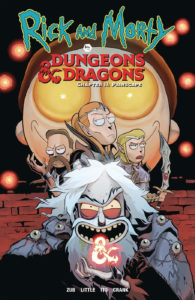I’ve talked about initial brainstorming, story progression and segmenting a comic story into issues/chapters. In this post I cover page-by-page pacing. It’s not a technique I hear much about, but I’ve found it invaluable for comic writing and hope you find it useful too.
Working with an artist who understands how to enhance and communicate a story makes a huge difference, but as the writer it’s your job to make that as easy and clear for them as possible. Comic writers need to think a bit like artists and comic artists need to think a bit like writers. The easiest way for me to understand where the visuals are all going to go and how they fit together is to create a quick page-by-page pacing list. It’s nothing fancy, but it is quite helpful.
I take a text file and create a row of page numbers and then go through my issue by issue breakdown to figure out how many pages each part of the issue will need. It gives me a simple way of measuring how much emphasis (page time, if you will) is being used for each scene. I can double check that it all fits and is well balanced before I start scripting. In an action-oriented series like Skullkickers I can make sure there’s enough ass kicking. It’s the main thrust of the series and I don’t want to get so caught up in talking scenes that I lose track of that emphasis on combat. The last two issues of each story arc are usually wall-to-wall action. For my other comic stories I have quite different plot/mood goals and adjust the pacing accordingly.
A page-by-page pacing list also gives me an easy way to ‘see’ where ‘page turners’ will go. Assuming my story starts on page 1, then each even-numbered page (2, 4, 6, 8, etc.) causes the reader to flip to a new spread. If I want to subtly encourage them to keep reading or reveal a big surprise, using the page count to my advantage helps a lot. If a character turns to look behind them because they think they’re being followed on the last panel of an odd-numbered page, we want to turn the page and find out who they see. That’s a cliché example of a page turner, but it works. If I put that reveal on the odd numbered page instead, then the reader would already have the surprise ruined for them as their peripheral vision picked it up.
Okay, so hopefully I’ve convinced you that a page-by-page pacing sheet has merit. Let me assure you, it’s not complex. It’s a point form list. Here’s an example of a pacing sheet from Skullkickers issue 3:
SKULLKICKERS #3
—
01 Camped out under the stars – full page
02 Banter/poison
03 Merchants prepping to attack
04 More banter/eat the stew
05 Peyote dream begins
06-08 DREAM and PROPHECY? – 3 page spread
09 Wake up/barf/revelation
10 Merchants fail
11 Travel to the tower. Dwarf sick.
12 Arrive at the fortress. Guards.
13 Sneak by first wave of skeletons
14 Sneak quietly inside
15 Exploration
16 Reveal the necromancer’s ‘lab’
17 Mistake
18 Fight breaks out
19 Fight
20 Fight
21 Fight/human hides
22 Dwarf captured by necromancer – full page
Yup. That’s it. Just a simple list justifying the existence of each page.
Want to see how it all played out in the comic? You can read the whole issue starting right HERE.
In Skullkickers the pacing list is usually quite simple. On more complex stories I’ll have more points per line, but the overall approach is similar. The page-by-page pacing gives me a clear sense of how much time is being given to each scene, where the page turners will be and ensures that all the plot points I need covered in the issue will fit.
I still have tons of creative flexibility in how all of the above is presented when I do my actual scripting, but it’s a crucial map. When I start scripting I have clear goals about where it’s headed and don’t waste time writing material that isn’t relevant. If I come up with a better way to pace things as I script, I’ll usually go back to my page-by-page list and adjust it, so when I stop mid-script my plan accurately reflects what I’ve already completed.
The issue breakdown and page pacing also act as an important reminder and inspiration point for me. When I’m juggling multiple (often, very different) projects at the same time it can be tough to get ‘back into the groove’ on writing. Having a plan puts me back in the right head space to keep working. It’s far easier for me to write at odd times or in strange places because the story plan solidifies my productivity. I’ve written at airports, on trans-Atlantic flights, in hotel rooms… anywhere I can get my laptop up and running. Even when things are crazy-busy I can find time to write one or two pages inbetween a hundred other things that need to get done. I can walk away and, when I come back, that outline and pacing sheet reminds me of where I was and where I need to go.
My comic writing method front loads most of the story building at the start, developing the road map. By the time I sit down to actually script, almost all of those technical/plot issues are solved so I’m free to concentrate fully on describing really cool places, brainstorming wild action or coming up with catchy/ interesting dialogue. I’m no longer worried about whether or not the page I’m working on at that moment is going to be relevant or pace properly – it does and it will because I already figured it out, issue-by-issue and then page-by-page.
In my next post I’ll talk about the actual scripting process. I hope you find my ramblings useful. If so, feel free to let me know here (or on Twitter) and share the posts with your friends.





 Zub on Amazon
Zub on Amazon Zub on Instagram
Zub on Instagram Zub on Twitter
Zub on Twitter
Hi, my names Steven and reading your tips and guidelines have really helped me and inspired me to make my own stories. for me it is really tough getting a story going along. But with these tips I can more understand which direction I am supposed to be heading with my own action story.
I’m only fifteen with a lot of drawing experience but i feel there more to it than just drawing. I feel that to actually knowing what our drawing or to know what the character is feeling is to write the script and story yourself. I know that it will be tough but i believe that I can actually do it. Thanks for all the amazing advice you are truly great. 🙂
Very helpful post, this happens to be quite challenging to me
Holy guacamoley! The information so far has been super helpful on how to break these things down. I have always been a “pick up the pencil and just start drawing the comic out” kind of person, but that’s always ended up with a couple of pages, and then loss of interest or idea of where to take my story. I feel that writing and planning ahead of time would be a great asset in my journey. I’ve been making comics (for fun, never more than a few pages) since I was a kid, now I am 30 and still love it, but feel lost. So thank you for helping inspire and teach me. <3 Much love!